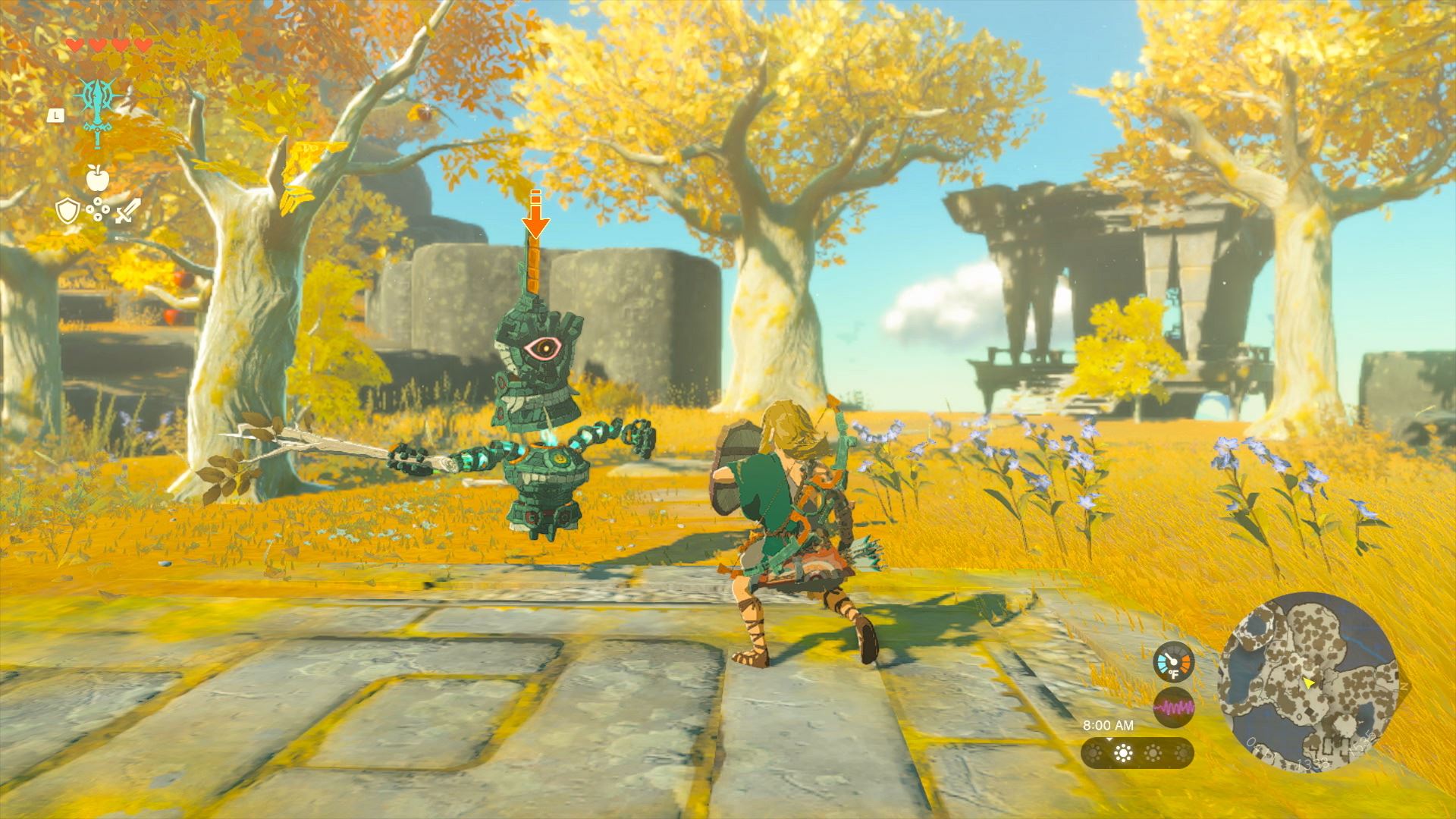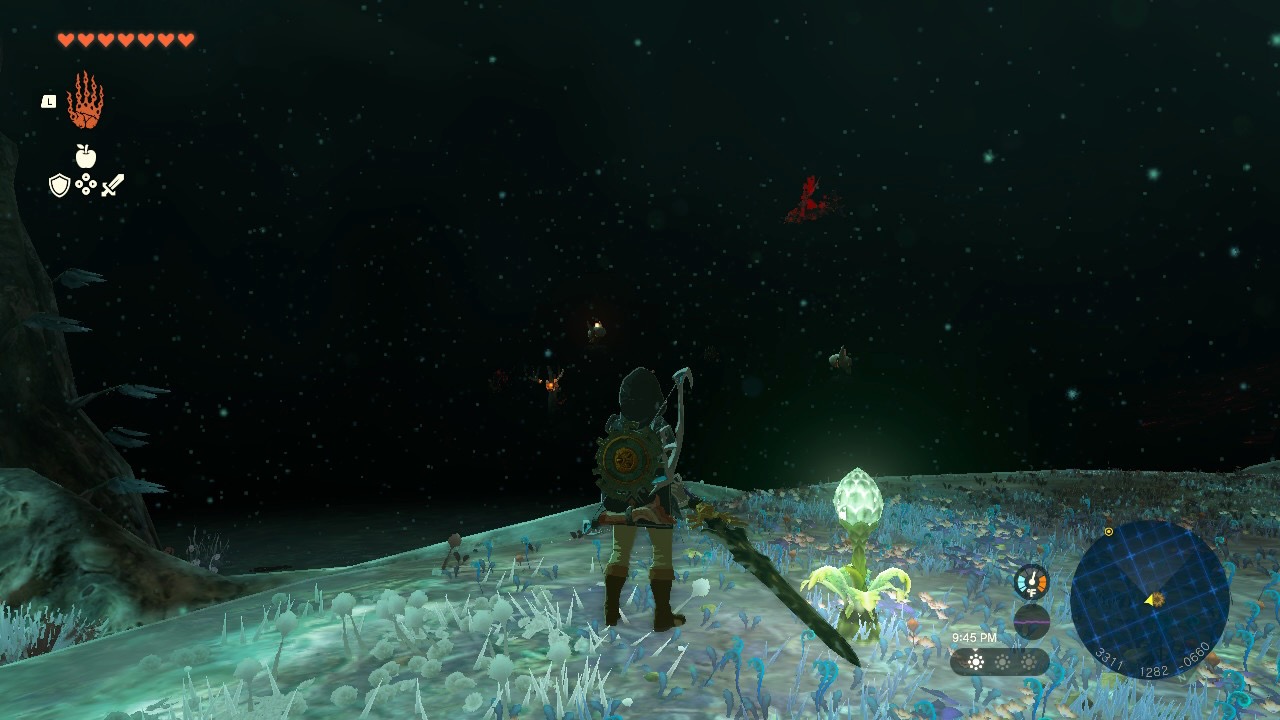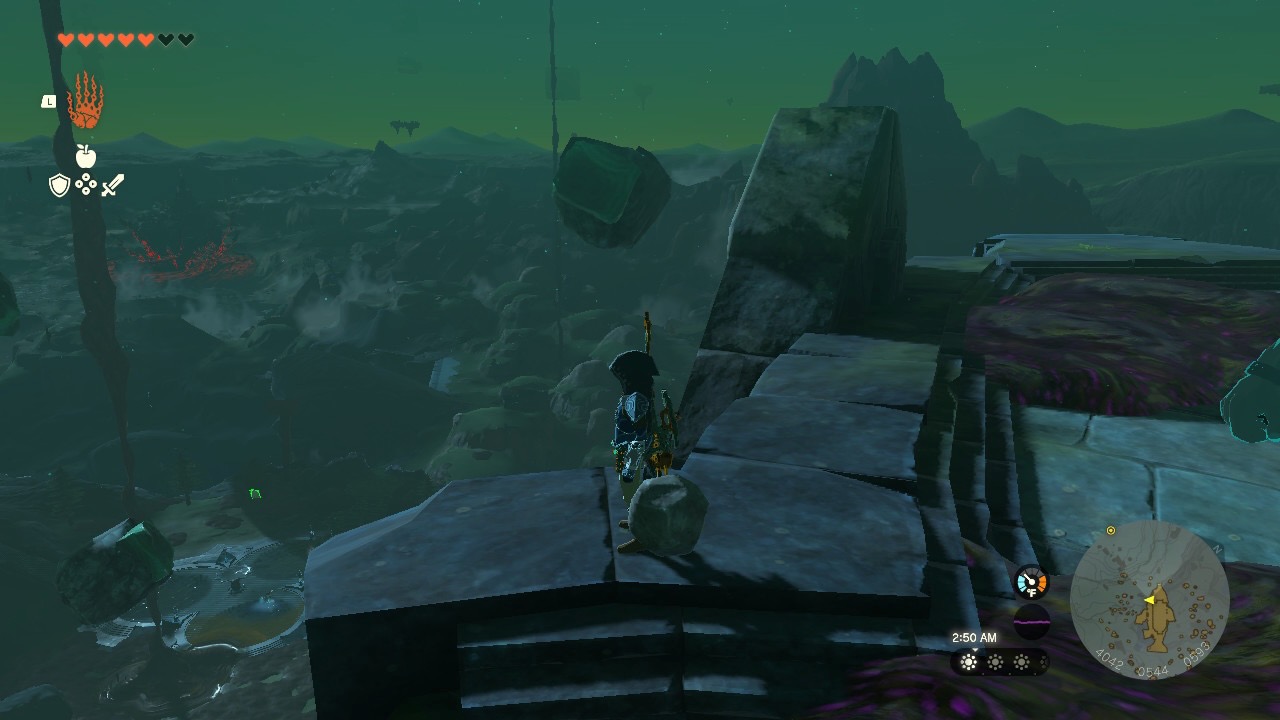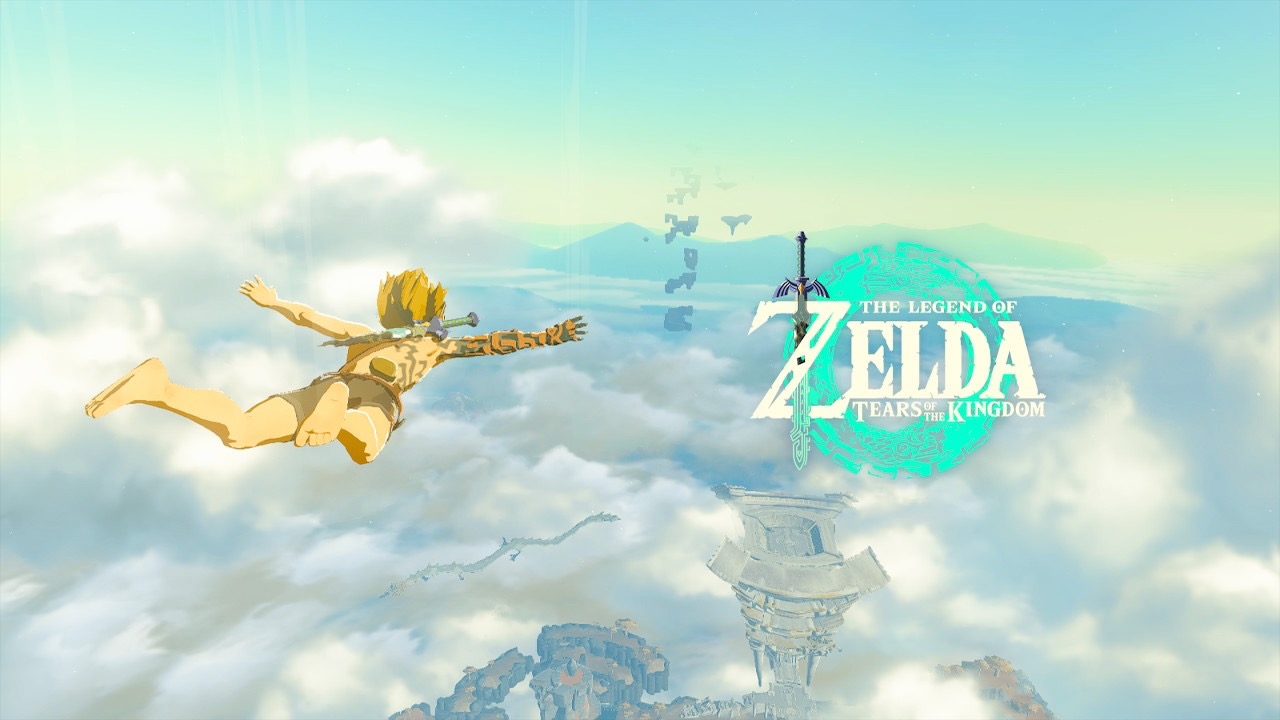
The Legend of Zelda: Tears of the Kingdom improves on 2017’s Breath of the Wild in nearly every way.
It’s more visually impressive because it’s built from the ground up for the Switch’s now ancient hardware and runs at a consistent frame rate, though there are still occasional minor performance dips when a lot is going on, even when playing in handheld mode. It also kicks Breath of the Wild‘s sense of freedom up several notches thanks to its new ‘Zonai’ construction mechanics and ‘Ultrahand,’ which allow you to truly “build your own adventure.”
There are other noteworthy quality-of-life upgrades, including displaying recipes more visually, quick access to menus and the ability to combine most weapons with ‘Fuse,’ a feature that makes breaking your favourite sword less annoying because attaching a Stalfos‘ arm to it is undeniably cool (weapons breaking is still a little frustrating sometimes, unfortunately).
But the game isn’t nearly as impactful as Breath of the Wild simply because it’s a true sequel — a first for the Zelda franchise. I also can’t help but wonder how much better Tears of the Kingdom would look running on more modern hardware (where’s the mythical Switch Pro/Switch 2, Nintendo?). That’s not to say that the latest Zelda isn’t visually stunning. It’s the best-looking Switch title yet, but at times, the rampant aliasing and low-resolution textures can make it look muddy, especially when playing on a TV with the Switch docked.
Tears of the Kingdom isn’t a reinvention of the iconic Zelda series like Breath of the Wild. It features mostly the same core mechanics, swordplay and even world as its predecessor, though I enjoy treading through the remixed Hyrule because it’s significantly changed in some regions. The last time I played Breath of the Wild was over four years ago, and I remember very little about the game, so that likely helps, too.
The fact that Tears of the Kingdom takes place in the same world as Breath of the Wild was one of my key concerns leading up to its release, especially since the game has been in development for roughly six years. Part of what makes Breath of the Wild so special is the sense of exploration it fosters. Is that feeling of wonder gone if I’m traversing the same world? Thankfully, during my time with the game so far, I find myself always still wondering what’s over that next hill, even if some areas and characters are familiar.
The game’s world feels different in other ways, too. In Tears of the Kingdom, there are the ‘Sky’ and the ‘Depths,’ two new regions above and below Hyrule. While the Sky’s floating islands have been featured in Nintendo’s marketing leading up to Tears of the Kingdom‘s release, the Depths have been mostly kept under wraps.
Without revealing spoilers, the Sky’s floating islands are sparsely distributed across Hyrule (though there is more to explore than you might suspect). Then there’s the sprawling subterranean Depths and its pitch-black areas that task the player with brightening their surroundings. As a side note, it’s very cool (and satisfying) to dive down from the Sky all the way to the Depths. There’s a tremendous sense of scale to Tears of the Kingdom that I have not experienced before in an open world game.
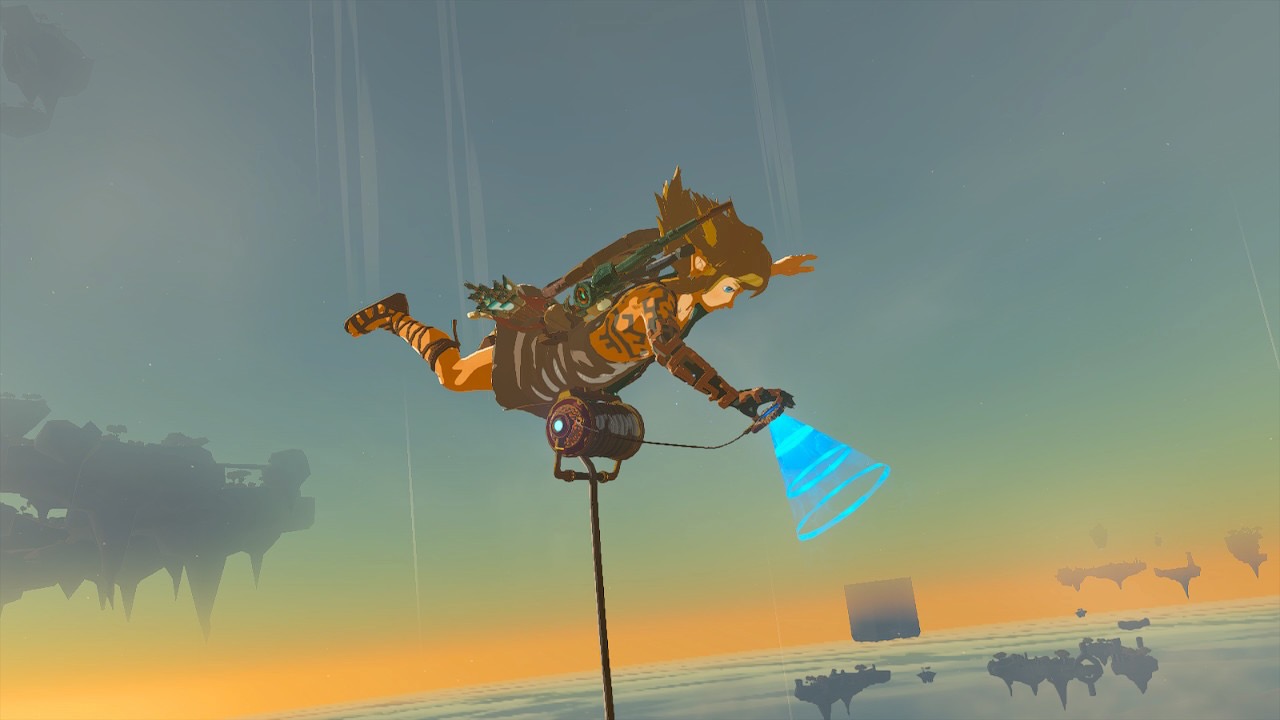 I haven’t spent much time in the Depths yet, but my minimal spelunking has been surprisingly tense and survival horror-inspired. You never know what will come leaping out of the dark or what’s beyond that glowing Brightbloom seed you just attached to an arrow and shot across the cave.
I haven’t spent much time in the Depths yet, but my minimal spelunking has been surprisingly tense and survival horror-inspired. You never know what will come leaping out of the dark or what’s beyond that glowing Brightbloom seed you just attached to an arrow and shot across the cave.
In Tears of the Kingdom, Breath of the Wild‘s abilities like ‘Magnesis’ and ‘Cryonis’ are gone, and in their place are ‘Ultrahand,’ the new power Link uses to grab objects and move them around; ‘Fuse,’ the ability to combine items together, ‘Ascend,’ which shoots you upwards through surfaces above you, and ‘Recall,’ the power to turn back time (there are a few other surprises). Throughout the game’s several dungeons (Shrines are back, too), which are a noticeable step above Breath of the Wild‘s in depth and challenge (at least so far), you’ll use these various powers in unique ways to solve puzzles, like reaching a specific tower by creating a makeshift ramp out of planks, crafting a fan-powered flying vehicle with the help of Zonai fans and batteries, or floating through the sky in water droplets.
Much of Tears of the Kingdom‘s improved sense of freedom is powered by Zonai devices alongside Link’s Ultrahand and Fuse abilities. Zonai items, which are usually slightly out of place in the world of Zelda, include ‘Fans,’ ‘Rockets,’ ‘Wheels,’ ‘Batteries,’ platforms and more. They allow you to solve most puzzles exactly how you want.
They’re not an infinite resource, though. You’ll need to use up Zonai Charges (which are gathered by taking out Zonai enemies) in gacha machine-like devices to unlock various Zonai items. This means they need to be used strategically and that they can run out, something I’ve encountered frequently during my 45+ hours with the game so far. You also can’t use them under some circumstances during certain parts of the game.
For example, if you want to attach a Rocket to your shield to reach that floating platform, that’s possible. But maybe you should hang on to your Rockets and save them for a more difficult puzzle because two planks are leaning against a nearby wall. Instead, use Ultrahand and attach them together to create a bridge. In nearly all instances during my time with Tears of the Kingdom, any idea I came up with was possible, regardless of how wacky.
For example, instead of finding the correct, straightforward way around a mountain, I chopped down every tree in sight and used Link’s Ultrahand ability to combine the trunks into one long, awkward bridge that I then placed on an angle on the cliffside to climb up it. Was this the easiest way of accomplishing this task? No, but it gave me an immense sense of satisfaction that it actually worked.
I’ve also had a lot of fun with Fuse. Most will be surprised at how effective a generic, low-level ‘Spear’ can be with a ‘Beam Emitter’ Zonai device attached to it or the hilarity of adding a rock to a ‘Boomerang’ to create an aptly named “Rock Boomerang.’ Fuse can be a little awkward because it forces you to drop the item you want to add to the weapon Link is holding, but after the first few instances of using the ability, it starts to feel natural. Still, it would have been great if Nintendo added a way to use the ability through the menu.
And finally, Champion Abilities return in a new form in Tears of the Kingdom. I want to avoid spoilers, so I won’t reveal much, but Tears of the Kingdom‘s Sage abilities are very useful, particularly Goron Yunobo’s rolling attack (it’s saved me several times when I’ve been down to one Heart while fighting a group of enemies).
But Tears of the Kingdom isn’t perfect. Its voice acting remains awful for the most part, and while I’ve never been a fan of the series’ often convoluted narrative, the game’s tale of Zelda mysteriously disappearing isn’t much of an improvement over Breath of the Wild‘s mostly nonexistent story (I briefly tested out the Japanese voice acting and it’s great, thankfully). That said, I do find myself actually curious about the havoc caused across Hyrule by the mysterious Malice, which is more than I can say for Tears of the Kingdom‘s predecessor. And to be fair, I haven’t entirely completed the game’s story yet.
 I also absolutely hate that you still need to find towers to unlock most of Tears of the Kingdom’s map, just like in Breath of the Wild. If I’ve travelled through an area, it should just appear on the map and not remain blacked out. In that same vein, the game’s combat can still be finicky and frustrating, especially towards the beginning when enemies feel more powerful than Link in some areas of the map.
I also absolutely hate that you still need to find towers to unlock most of Tears of the Kingdom’s map, just like in Breath of the Wild. If I’ve travelled through an area, it should just appear on the map and not remain blacked out. In that same vein, the game’s combat can still be finicky and frustrating, especially towards the beginning when enemies feel more powerful than Link in some areas of the map.
Overall, Tears of the Kingdom is a far more polished take on the open world direction the Zelda series shifted towards with Breath of the Wild. Nearly everything about the game is an improvement over its predecessor, and I’ve had a great time with it so far.
With a little over 45 hours spent in The Legend of Zelda: Tears of the Kingdom, I still feel like I’ve only just scratched the surface of what Nintendo’s latest Zelda title has to offer, and I find myself excited to dive back into it for the next several weeks.
If you own a Nintendo Switch, Tears of the Kingdom is an absolute must-buy, and as far the Zelda series goes, it’s one of the best in the franchise, despite being its first true sequel.
The Legend of Zelda: Tears of the Kingdom releases on May 12th on the Nintendo Switch for $89.99.
MobileSyrup utilizes affiliate partnerships. These partnerships do not influence our editorial content, though we may earn a commission on purchases made via these links that helps fund the journalism provided free on our website.
MobileSyrup may earn a commission from purchases made via our links, which helps fund the journalism we provide free on our website. These links do not influence our editorial content. Support us here.

